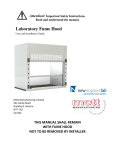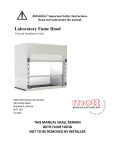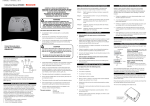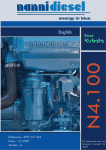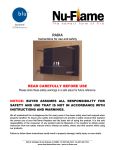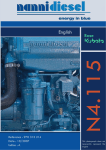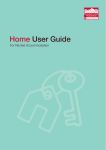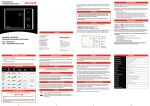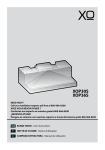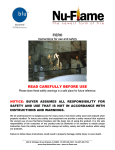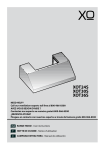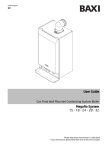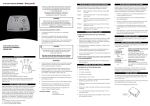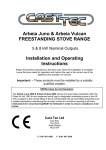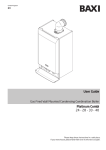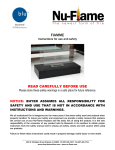Download Home safety - Somerset Homelet
Transcript
Home safety www.dsfire.gov.uk Acting to Protect & Save Fire safety in the home Protecting your home It is the aim of Devon & Somerset Fire & Rescue Service to provide help and advice to prevent fires from occurring. The damage caused by fire in the home has devastating consequences and so many incidents we attend can be easily prevented. We will always be there to help in an emergency should your preventative measures fail. This booklet has been produced to give you guidance and advice on how to ensure your home is protectedfrom fire. •call 999 You can prevent most fires in the home by being aware of the dangers that will help you avoid the risk of a fire starting in your home. After reading through this booklet we suggest you complete the check list at the back. It will only take a few minutes and the advice and guidance it contains could save your life or that of a family member. www.dsfire.gov.uk Remember, if a fire breaks out in your home always •get out •stay out If you rent out your home or use it for Child-minding, you may need a higher standard of fire safety. Please visit our website for further information. www.dsfire.gov.uk Statistics show that you’re twice as likely to die in a fire if you don’t have a smoke alarm that works. More people die from the smoke inhalation rather than the fire itself. An average of 90 people die each year due to the battery in their alarm being flat or missing. LPCB Smoke Alarms • Smoke alarms are inexpensive and easy to install. • They are available from DIY stores, electrical shops and most high street supermarkets. • There are a variety of different models to choose from. Look out for one of these symbols, which show the alarm is approved and safe. 3 Types of smoke alarms available Alarms that have ten year batteries is the preferred option, however alarms which require the battery to be replaced regularly are quite acceptable. Ionisation alarms are generally more effective at detecting fast; flaming fires which consume combustible materials rapidly and spread fire quickly e.gpaper, flaming curtains, oil. These are the cheapest and most readily available, starting at as little as £5.00. Optical alarms are more effective at detecting slow burning fires e.g overheated wiring. Optical alarms are less likely to go off accidentally and as such are best for ground-floor hallways and for homes on one level. Strobe light and vibrating-pad alarms are available for those who are deaf or hard of hearing. Mains powered alarms are powered by your home power supply. They need to be installed by a qualified electrician. It is possible to have linked alarms installed, so that when one alarm detects a fire they all go off together. This is useful if you live in a large house or over several levels or for people with hearing difficulties. Fitting your smoke alarm • A smoke alarm should be fitted on each level of your property. • The ideal position is on the ceiling, in the middle of a room, hallway and landing, so you can hear the alarm throughout your home. • The alarm should be fitted at least 30cm away from a wall or light fitting. • Do not put alarms in or near kitchens or bathrooms where smoke or steam can set them off by accident. • Follow the instructions supplied with the alarm and keep the User Manual for future reference. Prices start at about £15.00. www.dsfire.gov.uk 5 Testing your smoke alarm • If you have an alarm that requires batteries. the fire and rescue service recommend that this is done on a date that is easy to remember, for example your birthday or a special anniversary. • Never disconnect, remove or take the batteries out of your alarm if it goes off by mistake – refer to manufacturer’s instructions as to what to do next (If batteries are changeable it could simply be that they need replacing). Make checking your smoke alarm part of your regular household routine • Every three months if you can, open the case and gently vacuum using a vacuum fitted with the soft brush attachment – if the case doesn’t open, vacuum over and around the case of the alarm. • If your smoke alarm starts to beep on a regular basis, you need to replace the battery immediately. • All alarms should be renewed after a 10 years. • 10 year alarms still require testing. • Test all smoke alarms every week, always follow manufacturer’s instructions. www.dsfire.gov.uk 7 How to prevent common fires Over half of home fires are caused by cooking accidents. Do • keep the oven, hob and grill clean and in good working order. A build up of fat and grease can catch fire • avoid leaving children in the kitchen alone when cooking on the hob • keep matches and sauce pan handles out of the reach of children to keep them safe • take care if you’re wearing loose clothing – they can easily catch fire • keep tea towels and cloths away from the cooker and hob • use Spark devices to light gas cookers as they are safer than matches and lighters as they don’t have a naked flame Deep fat frying What to do if a pan catches fire • Take care when cooking with hot oil – it sets alight easily. • Turn off the heat if it’s safe to do so. • Don’t fill the pan more than a third full of oil. • Don’t tackle the fire yourself. • double check the cooker is off when you’ve finished cooking. • Make sure food is dry before putting it in hot oil so it doesn’t splash. Don’t • don’t leave electrical wiring near or on top of the cooker • If the oil starts to smoke – it’s too hot. Turn off the heat and leave it to cool. • Fire blankets are useful to wrap a person whose clothes are on fire. • Use a thermostat controlled electric, deep fat fryer - they can’t overheat. • It is recommended that they are kept near or in the kitchen. • do not leave cooking unattended Fire Blankets • don’t leave saucepan handles sticking out (this avoids them getting knocked off the stove). Full www.dsfire.gov.uk • Never throw water over it. FIRE BLANKET 9 Toasters and microwaves Wheat bags • Check toasters are clean and crumbs emptied out regularly. Wheat bags are heating pads that usually contain buckwheat or wheatgrass, which can be warmed in a microwave. • Ensure toasters are placed away from curtains and kitchen rolls and do not use directly underneath overhanging cupboards. • Follow the instructions carefully for use of microwave. • Never put anything metal in the microwave. Do • only use as a heat pack for direct application to the body Don’t • use a wheat bag as a bed warmer • overheat the bag • reheat the bag until it has completely cooled – this can take up to two hours • ensure your microwave turntable is working properly • leave the microwave unattended when heating • watch for signs of overuse such as burning or charring • store the bag until it has completely cooled • use the bag if you see evidence of damage. • leave bags to cool in a safe area and on a non-combustible surface. WHEAT WHE BAG AG Completely cool down www.dsfire.gov.uk 11 Take care with electrics Faulty electrics, appliances, wiring and overloaded sockets are the cause of around 7000 house fires across the country every year. • Certain appliances, such as washing machines, should have a single plug to themselves, as they are high powered. How to avoid electrical fires • Remember to check and replace any old cables and leads. • Make sure an electrical appliance has a British or European safety mark when you buy it. • Keep electrics (leads and appliances) away from water. • Remember - one plug per socket. If you need more plugs than there are sockets, use a bar type’ fuse adaptor. • Unplug appliances at night or when you’re not using them to reduce the risk of fire. • An extension lead or adaptor will have a limit to how many amps it can take, so be careful not to overload them to reduce the risk of fire. Appliances use different amounts of power – a television may use a 3amp plug and a vacuum cleaner a 5amp plug for example. • Keep electrical appliances clean and in good working order to prevent them starting a fire. • Watch for signs of dangerous or loose wiring such as: scorch marks; hot plugs and sockets; fuses that blow; circuit breakers that trip for no obvious reasons; flickering lights. Lights • Don’t position lights or bulbs near curtains and other fabrics. The heat, which you cannot see, will set the fabric above alight within hours. • Ensure you have the correct bulb for the light fitting. • When installing lights, such as down-lighters, only use a qualified electrician. 40w 40w www.dsfire.gov.uk 13 Using an electric blanket Portable heaters • Don’t leave electric blankets folded as this damages the internal wiring. Store them flat or rolled up instead. • Try to secure heaters up against a wall to stop them falling over. • Never use the blanket if it is wet and never switch it on to dry it out. • Unplug blankets before you get into bed, unless it has a thermostat control for safe all-night use. • Don’t buy second hand blankets. • Check regularly for wear and tear. • Have your blanket checked by a qualified electrician at least every three years. www.dsfire.gov.uk • Keep them clear from curtains and furniture and never use them for drying clothes. • Don’t put anything on top of heaters. • Do not move a heater while it is switched on. • Ensure your appliances are regularly serviced by a qualified engineer. • Do not leave young children or pets unattended in areas where portable heaters are switched on. 15 Open fires, wood-burners and multi fuel stoves Carbon Monoxide (CO) • Always place a fireguard around the fire. You can’t see it! You can’t taste it! You can’t smell it! • Do not overfill fire baskets. CO is the most common form of household poison. • Only burn suitable items in solid fuel burners. • Have chimneys swept regularly. • Dispose of ash appropriately after you have allowed it to cool completely. • Do not dry or air clothes on a fireguard. • Ensure fires are extinguished before you go to bed. CO gas is produced by incomplete burning of carbon-based fuels, including gas, oil, wood and coal. Carbon-based fuels are safe to use. It is only when the fuel does not burn properly that excess CO is produced, which is poisonous. Poisoning occurs when gas appliances and flues have not been properly installed, maintained or are poorly ventilated. The symptoms The early symptoms of poisoning can be easily confused with many common ailments and can develop quickly or over a number or days or months. www.dsfire.gov.uk Look out for: • a headache – this is the most common symptom • feeling sick and dizzy • feeling tired and confused • being sick and having stomach pain • shortness of breath and difficulty breathing. The danger signs • Yellow or orange rather than blue flames (except fuel effect fires or flueless appliances which display this colour flame). • Soot or yellow/brown staining around or on appliances. • Pilot lights that frequently blow out. • Increased condensation inside windows. 17 Take action Top tips for prevention If you think you have carbon monoxide poisoning, you should: • Installation, repair and regular servicing of any gas and fossil fuel appliances and flues and chimneys should be done by a Gas Safe registered engineer. • seek urgent medical advice from either you GP or your A&E department • open the windows and doors to ventilate the room, and don’t sleep in it • Make sure you have good ventilation and enough fresh air in the room containing your gas appliance. • switch off all your gas appliances and don’t use them again until the problem has been fixed • Ensure chimneys/flues aren’t blocked and vents aren’t covered. • shut off the gas supply at the meter control valve • Get your chimney swept from top to bottom – if gas continues to escape, call the Gas at least once a year by a qualified sweep. Emergency free phone number on 0800 111 999 • call a Gas Safe registered engineer to check all your gas appliances. www.dsfire.gov.uk Gas safe engineers You can check if an engineer is on the register by visiting the website: www.gassaferegister.co.uk Carbon monoxide alarms Carbon Monoxide alarms are useful but aren’t a substitute for proper installation and maintenance of gas appliances. Make sure the alarm meets British Standard EN50291 and ideally the British Standard Kite mark. You should install, check and service CO alarms according to the manufacturer’s instructions. CO alarms are available from DIY and hardware stores. 19 Cigarettes Cigarettes can burn at temperatures of over 700 degrees centigrade – they are hotter than you think! • Stub cigarettes out properly and dispose of them carefully. • Never smoke in bed. • Don’t leave a lit cigarette, cigar or pipe lying around. They can easily fall over and start a fire. • Use a proper ashtray – never a wastepaper basket. • Make sure your ashtray can’t tip over and is made of a material that can’t burn. • Take extra care if you smoke when you’re tired, taking prescription drugs, or if you’ve been drinking. You might fall asleep and set your bed or sofa on fire. • Keep matches and lighters out of children’s reaches. • Consider buying child resistant lighters and match boxes. Candles Joss sticks and oil/incense burners More than 50 fires a day are started by candles Tea lights (sometimes known as night-lights) • Make sure candles are secured in a proper holder and away from materials that may catch fire – like curtains. Tea lights present a high risk. They have a foil outer container; however this is not a suitable holder. This foil container can get extremely hot and melt surfaces on which it is placed making it a fire hazard. • Put candles out when you leave the room and make sure they’re put out completely at night – never leave burning candles unattended. • Use a snuffer or a spoon to put out candles. It’s safer than blowing them out when sparks can fly. Furniture Always ensure that your furniture has the fire-resistant permanent label. • Children shouldn’t be left alone with lit candles. ANT RESIST www.dsfire.gov.uk 21 Planning a safe escape Fitting a smoke alarm is the first crucial step to protecting yourself from fire. But what would you do if it went off during the night? This section will help you make a plan ready for an emergency. • Keep door and window keys where everyone can find them. What to do if there is a fire. Be prepared by making an escape plan • Don’t tackle the fire yourself. Leave it to the professionals. • Plan an escape route and make sure everyone who lives in or visits your home knows how to escape. • Make sure the escape routes and exits are kept clear. • The best route is the normal way in and out of your home. • Keep calm and act quickly, get everyone out as soon as possible and always close doors behind you. • Don’t waste time investigating what’s happened or rescuing valuables. • If there’s smoke, keep low where the air is clear. • Think of a second route in case the first one is blocked. • Before you open a door check if it’s warm. If it is, don’t open it – fire is on the other side. • Take a few moments to practice your escape plan. •Call 999 as soon as you’re clear of the building. 999 calls are free. • If the layout of your home changes or circumstances changes, review your plan. www.dsfire.gov.uk 23 What to do if your escape route is blocked How to escape from a high level building • If you can’t get out, get everyone into one room, ideally with a window and a phone. • Avoid using lifts and balconies if there is a fire. • Put bedding around the bottom of the door to block out the smoke, then open the window and call “HELP, FIRE!” • If you’re on the ground or first floor, you may be able to escape through a window. • Use bedding to cushion your fall and lower yourself down carefully. Don’t jump. • If you can’t open the window break the glass in the bottom corner. Make jagged edges safe with a towel or blanket. www.dsfire.gov.uk • It is easy to get confused in smoke, so count how many doors you need to go through to reach the stairs. • Check there is nothing in the corridors or stairways that could catch fire – like boxes or rubbish. • Make sure doors to stairways are not locked. • Make sure everyone in the building knows where the fire alarms are. • You should still get a smoke alarm for your own home, even if there is a warning system in the block. 25 What to do if your clothes catch fire When Children are in the home • Don’t run around, you’ll make the flames worse. • Fires account for nearly half of all accidental child deaths. • Don’t let children play or leave toys near a fire or heater. • 6000 fires a year are caused by children under the age of 10. • Put child locks on cupboards that have anything in them that children could use to start a fire. Find out what you can do to make sure your children are never affected by fire. • Keep portable heaters in a safe place, both when they’re being used and when they’re being stored. Make your home fire-safe for children. It is crucial to be aware that children can start a fire in moments, but only if they can get hold of materials that can start fire. • Put plug guards into sockets so children can’t stick things into the holes. • Lie down and roll around. It makes it harder for the fire to spread. • Smother the flames with a heavy material like a coat or blanket. •Remember, stop, drop and roll! • Keep matches and lighters out of reach and out of sight of children. • Keep your escape route clear of toys and other obstructions. • Don’t leave children alone in the home. • Unplug appliances that children could trip over. • Position lighted candles out of reach of children and pets. • Put a childproof fire guard in front of an open fire or heater if there are children in the house. www.dsfire.gov.uk 27 Teach children about the dangers of fire • You should tell children about how destructive fire can be and how rapidly it can spread. Older children may know that fire is dangerous, but might not realise how uncontrollable it can become, or that breathing toxic smoke can quickly kill you. • Teach them how to be safe with fire. • Encourage children to tell you if they find matches or lighters. Let them see you being careful about fire risks. Fascination with Fire • Hoax calls to the fire and rescue service puts lives in danger. • Parents or guardians have a legal responsibility for any illegal actions carried out by children. • People caught making hoax calls can be fined or imprisoned. The fire and rescue service can recover costs from responding to hoax calls. • Older children can take part in safe activities with fire, like lighting a bonfire or a candle while supervised by an adult. • Children can play with fire for reasons other than curiosity – for example, to get attention or because of peer pressure. • Devon & Somerset Fire and Rescue Service offers a confidential service where a specially trained fire advisor visits you and your child at home to give advice and education. For more information contact Firesetters on Hoax www.dsfire.gov.uk Some children can become dangerously obsessed with fires. If you know children who may be lighting fires deliberately, you can do something about it. e: [email protected] t: 01392 872315 w: www.dsfire.gov.uk 29 Living in a rented home By law your landlord must; Make a bedtime check Landlords don’t always have a legal responsibility to fit a smoke alarm, but under the 2004 Housing Act they must make sure there are adequate escape routes and depending on the size they may have to fit smoke alarms and provide fire extinguishers. • make sure that all gas appliances they provide are maintained in good working order and that a registered Gas Safe engineer carries out a safety check each year You are more at risk from a fire when asleep. So it’s a good idea to check your home before you go to bed. • ensure all electrical installations (fixed wiring, etc.) and any electrical appliances they provide (fridge, freezers, cookers etc.) all properly maintained and safe to use • close inside doors at night to stop a fire from spreading If you feel that your landlord hasn’t kept to the Housing Act or if you need more information about it, contact the local Environmental Health Officer or Citizens Advice Bureau. • ensure any furniture and furnishings they provide meet the fire resistance regulations. Check list • turn off and unplug electrical appliances unless they are designed to be left on – like your freezer • check your cooker is turned off • don’t leave the washing machine on • turn heaters off and put up fireguards • put candles and cigarettes out properly • make sure exits are clear ANT RESIST www.dsfire.gov.uk • keep door and window keys where everyone can find them. 31 Self- Assessment Regular checks and maintenance Every day: Every 3 years: • make a bedtime check before you go to bed. • have your electric blanket check by a qualified electrician. Every week: • test your smoke alarm battery/carbon monoxide alarm. Every month: Every 10 years: To ensure that you have read and understood all the safety advice contained within this book please take a few minutes to read the following questions. If there are any questions that you are unsure of the answer to, please turn to the indicated page to familiarise yourself with the safety advice. • service any major electrical appliances • change your smoke alarm. Check list • vacuum off your alarm. Detection Every year: 1. Do you know the different types of smoke alarms available? page 4 • have all gas appliances serviced by a qualified inspector 2. If you have extra needs, such as hearing or sight difficulties, do you know the special types of smoke alarm available? page 4 • replace your smoke alarm battery (unless the alarm is a 10 year alarm) 3. Do you know how many smoke alarms to have and the best place to position them? page 5 • ensure your house number/name can be seen from the roadway byemergency services 4. Do you know how to maintain your smoke alarm? page 7 5. Do you know how to make sure your smoke alarm works? page 6 • have your chimney swept to keep it clean and prevent fires. www.dsfire.gov.uk Yes No 33 Yes Yes No Prevention No 18. If you are deaf or hard of hearing, do you know who you can contact for fire safety help and advice? ? 19. Do you know the fire safety check you should carry out every night before you go to bed? page 30-31 page 30 6. Do you know what shouldn’t put in a microwave? page 10 7. Do you know the maximum capacity of an extension lead or adaptor? page 12-13 8. Do you know the safest deep-fat fryer you can use? page 9 9. If you use a chip pan, do you know how much oil to use? page 9 20. Do you know why you should close room doors at night before you go to sleep? 10. Do you know what to do if a pan catches fire? page 9 Escape 11. Do you know the correct way to use and store electric blankets? page 14 21. Do you have an escape plan? page 22 12. Do you know the best place to position a portable heater? page 15 22. Do you know what to do if there’s a fire? page 22-23 23. Do you know what to do if your escape route is blocked? page 25 13. Do you know about safety checks for gas appliances and the dangers of Carbon Monoxide? page 17 24. Do you know what to do if your clothes catch fire? page 26 14. Do you know how many fires every year, across the country, are caused by overloading of sockets? page 12 25. If you live in a high-rise building, do you know the extra precautions you need to take when making your escape plan? page 25 15. Do you know the dangers of smoking in bed or when you’re tired? page 20 16. Do you know how many fires are started by candles each day? page 21 27. If you have or care for children, do you know the extra precautions you need to take to keep them and your home safe? page 27-28 17. Do you know how best to position and secure candles? page 21 www.dsfire.gov.uk 35 Contact us 01392 872200 [email protected] www.dsfire.gov.uk To request any information in this document in an alternative format or language please call 0800 731 1822 or email [email protected] www.dsfire.gov.uk Acting to Protect & Save





















